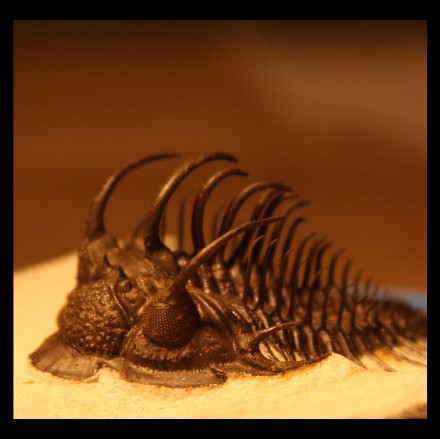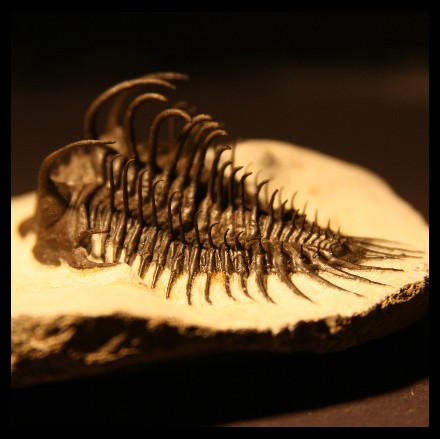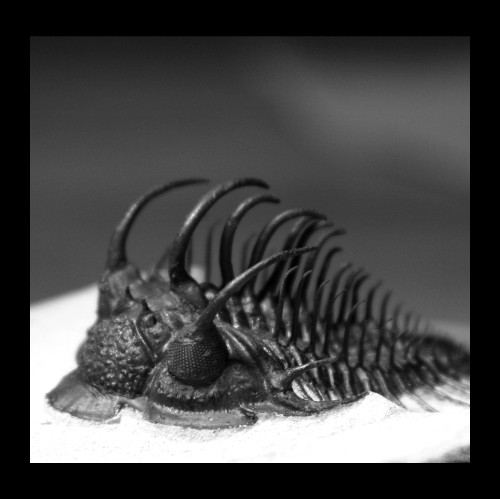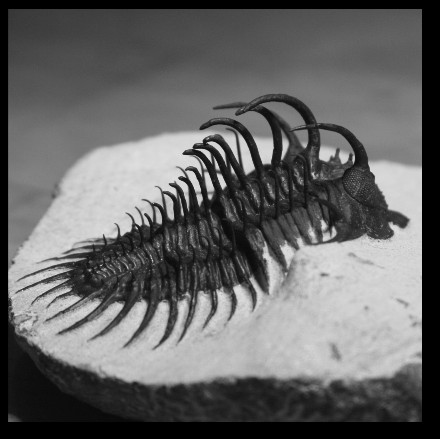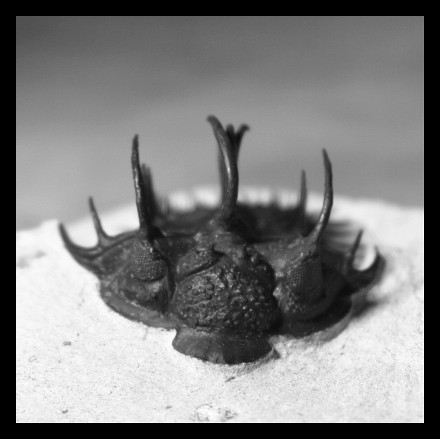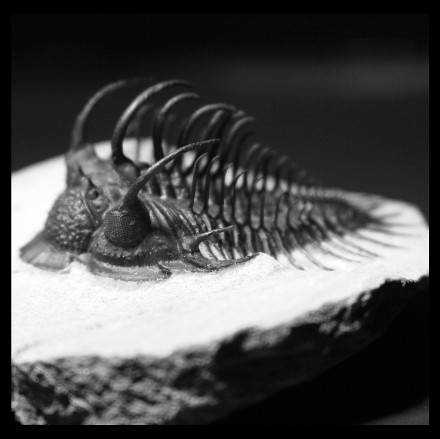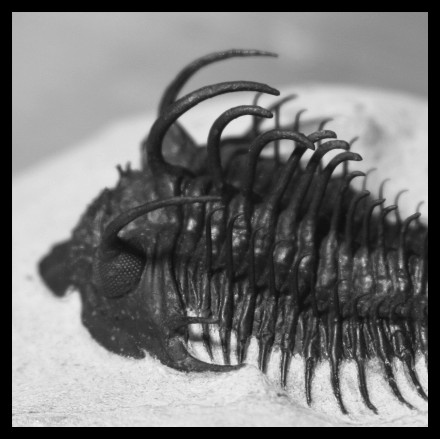Comura bultyncki MORZADEC 2001 is a Moroccan Devonian asteropygine.
Here a splendid complete specimen of one of the most spectacular species of trilobites known as “spiny,” quite simply because their spines are hyper-developed. For the collectors of asteropygines, as well as collectors of Moroccan trilobites, Comura bultyncki is a kind of a grail. There is little doubt of the species when you find one of them. On the other hand, beware of the fakes on the Net!
Order
|
Phacopida
|
SALTER 1864
|
Occurrence: Lower Ordovician (Tremadoc) to Upper Devonian (Famennian).
- Cephalon: Proparian (Phacopina and Cheirurina), gonatoparian
(Calymenina) or opisthoparian (Calymenina),
- Preglabellar field often very short or absent.
- 4 or fewer pairs of glabellar furrows.
- Eyes : when present, schizochroal (Phacopina) or holochroal (Cheirurina
and Calymenina).
- With rostral plates (Calymenina and Cheirurina) or without (some
Phacopina).
- Hypostome conterminant (all suborders) to impendent (some devonian
Phacopina).
- Exosqueletton generally granulous.
- Thorax: 8 – 19 segments, sometimes distinctly furrowed.
- Axis sometimes broad (e.g., Homalonotidae).
- Pygidium : Typically micropygous (most Calymenina and Phacopina),
but variable (e.g., subisopygous in Dalmanitoidea and Acastoidea).
- May be lobed or spiny (e.g., Cheirurina, some Dalmanitoidea, Acastoidea),
or smooth-margined, with round or subtriangular outline (e.g., Calymenina,
Phacopoidea).
|
Sub-order
|
Phacopina
|
STRUVE 1959
|
- Cephalon : Proparian sutures (sometimes fused).
- Schizochroal eyes.
- Glabella expands forwards.
- Librigena typically yoked as single piece.
- Hypostome conterminant to impendent, some with no rostral plate.
- Some with genal spines.
- Thorax: 10 to (typically) 11 segments.
- Pleurae furrowed, articulating facets distinct.
- Rounded, angular, or spinose tips.
- Pygidium : Typically smaller than cephalon (but subisopygous
in Dalmanitoidea and Acastoidea).
- Smooth or spinose.
|
Super-family
|
Acastoiedea
|
DELO 1935
|
- Cephalon : Axial furrows slightly to moderately divergent.
- Anterior glabellar lobes and furrows usually not fused (although furrows
may be indistinct).
- Eyes typically distant from posterior border furrows, but not strongly
anterior.
- Frontal glabellar lobe auxilliary impression system triangular in
outline.
- Maximum width of glabella adjacent to preglabellar furrow.
- Median region of glabella devoid of muscle scars.
- Cephalic margin "shouldered".
- Laterally convex course of genal margin topographically distinct from
curvature of axial margin.
- Thorax : Pleural endings blunt, rounded or angular.
- Sometimes spinose.
- Pygidium : Micropygous to subisopygous.
- Sometimes spinose (expressed as marginal spines).
- Pygidial axis with deep, apodemal anterior ring furrows, with abrupt
transition to shallow posterior ring furrows.
- Coincident decrease in angle of axial furrow convergence.
|
Family
|
Acastidae
|
EDGECOMBE 1993
|
- Cephalon : Semi-circular to rounded subtriangular.
- Cephalic border narrow in front of the glabella.
- Dorsal furrows slilghtly to moderately divergent.
- Anterior glabellar furrows (S3) simple.
- Medial furrows (S2) moderately deep.
- Deep posterior furrows (S1).
- L2 and L3 lateral glabellar lobes generally fused distally.
- Muscle scars bearing sometimes callosities (Acastinae).
- Eyes typically distant from the posterior genal furrows.
- Hypostoma
- Pygidium : micropygous to subisopygous.
- Semi-circular to rounded subtriangular.
- Short posterior spine present.
|
Sub-family |
Asteropyginae |
DELO 1935 |
Traditionnally included in the Dalmanitidae, Asteropyginae are now included
in the Acastids. Mostly benthic trilobites.
- Cephalon : Closely similar to the Dalamanatid Dalmanitides BARRANDE 1853.
- Glabella expanding forward.
- 3 lateral glabellar furrows.
- Eyes generally large.
- Genal angles acutely pointed or bearing medium-length to very long
genal spines in straight continuation of lateral margins.
- Pygidium : Rachis never reaching the posterior region of the
pygidial border.
- Generally 5 pairs of lateral spines (sometimes 4 or 6).
- Unpaired posterior lappet or spine.
|
| Genus |
Comura |
R. & E. RICHTER 1926 |
|
|
Species |
bultyncki |
MORZADEC 2001 |
- Cephalon : trapezoïdal strip/tongue in front of the cephalon.
- Long occipital spine
- Palpebral and metaxigenal spines
- 30 dorso-ventral files of with a maximum of 11 lenses per
file.
- Thorax : First thoracic ring without median spine on the rachis.
- Pygidium : 10 curved/bent axial rings.
- 5 pairs of pleural ribs, the 5 anterior pairs bearing in their distal part a pair of dorso-ventral spines.
- 5 pairs of lateral pygidial spines, whose 5th pair does not exceed subsequently the level of 4th.
- Median spine moderatly shorter than the 5th lateral spines.
|
- Cephalon :
In front of the cephalon, the limb widens in a strip of trapezoidal contour.
-
The occipital ring carries a long median spine bent backwards whose end reaches the level of the 5th thoracic ring.
-
The palpebral lobes present each one a bent spine.
-
On the posterior edge of the cephalon, a pair of metafixigenal spines.
-
The L3 lobes and the frontal lobe of glabella decorated with large tubercles.
-
Visual areas made up of 30 dorso-ventral files with a maximum of 12 lenses per file.
-
The genal points are short, reaching the level of the 4th thoracic segment.
- Thorax :
-
11 segments which all carry, except the first, a long median spine of which the length decreases towards the back and a vertical spine at the pleural ends.
-
The pleurae are prolonged by long pleural spines.
- Pygidium : 10 axial rings with on each one a long bent median spine.
- 5 - 6 pairs of pleural ribs, 5th and the 6th being reduced to has half-ribs, separated by broad pleural furrows.
- The former half-ribs are broader and more in relief that the posterior ones and present each one a vertical spine towards their distal end.
- The pygidial segmentation is of cometa type.
- The 5 pairs of pygidial spines are fine/thin, of sub-circular section and bent backwards.
-
The 4 first are of the same length, the shorter 5th does not exceed in length the 4th.
-
The median spine is slightly shorter than the fifth pair of lateral spines.
